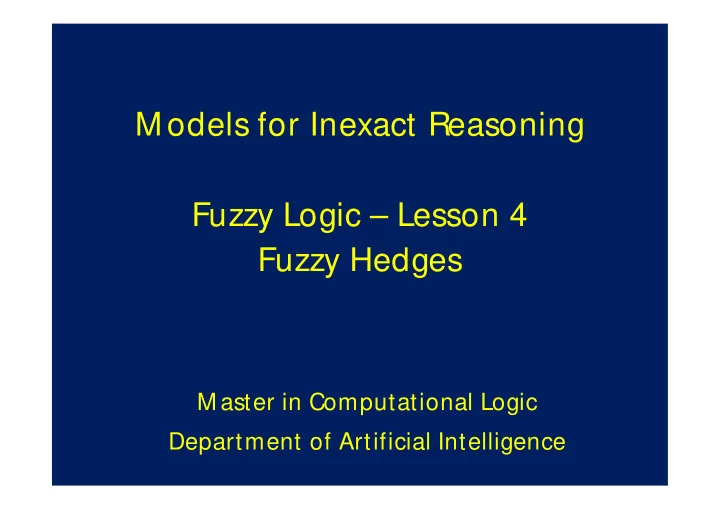

M odels for Inexact Reasoning Fuzzy Logic – Lesson 4 Fuzzy Hedges M aster in Computational Logic Department of Artificial Intelligence
Fuzzy Hedges • Hedges are special terms aimed to modify other linguistic terms • Can be used to modify elements such as: – Fuzzy predicates – Fuzzy truth values – Fuzzy probabilities • Examples: – “ Very”, “ more or less”, “ fairly”, “extremely”, etc.
Fuzzy Hedges – Examples • M odification of a fuzzy predicate – “ x is very young” • M odification of a fuzzy truth value – “ x is young is very true” • M odification of a fuzzy probability – “ x is young is very likely” • M odification of both a predicate and a truth value – “ x is very young is very true”
Linguistic M odifiers • Not applicable to crisp predicates, truth values and probabilities • Given a fuzzy proposition p, and a hedge H: Hp : x is HF • Hedges are represented by unary operations on [0, 1] • These operations are called “ modifiers” • Example: h (a) = a 2 is a modifier representing the hedge “ very”
Linguistic M odifiers • Given a fuzzy predicate p: “ x is F” and a hedge H represented by modifier h we have: µ = µ ( ) x h ( ( )) x HF F • Any modifier h is an increasing bijection [ ] < ∀ ∈ h a ( ) a , a 0,1 – Strong modifiers: [ ] > ∀ ∈ – Weak modifiers: h a ( ) a , a 0,1 [ ] = ∀ ∈ – Identity modifier: h a ( ) a , a 0,1
Strong and Weak M odifiers • Strong modifiers “strengthen” the predicate – Reduce the truth value of the associated proposition • Weak modifiers “ weaken” the predicate – Increase the truth value of the associated proposition • The identity modifier has no effect – The truth value of the associated proposition remains unchanged
Example • Predicates: – p 1 : “John is young” – p 2 : “John is very young” – p 3 : “John is fairly young” • Hedges: – H 1 : very, h 1 ( ∙ ) = a 2 – H 2 : fairly, h 2 ( ∙ ) = √ a • Age(John) = 26 • T( p 1 )? T( p 2 )? T( p 3 )?
Properties of modifiers • h(0) = 0 • h(1) = 1 • h is continuous • If h is strong, then h -1 is weak (and vice versa) • If h 1 , h 2 are modifiers, then (h 1 ° h 2 ) and (h 2 ° h 1 ) are modifiers • If both h 1 and h 2 are strong (weak) modifiers then so are the compositions
A Family of M odifiers • A class of functions that satisfies the previous conditions: a α + = α ∈ R h ( ) a , α • If ( α <1) then h α is a weak modifier • If ( α >1) then h α is a strong modifier • h 1 is the identity modifier • We can choose a suitable value for α depending on the context
The antonym • All fuzzy predicates have an antonym: • Example: – p : “ x is tall” – ap: “ x is short”
The antonym • Do not confuse the antonym with the negation!! – The negation of “ tall” is “ not tall” instead of “short ” • If E is a continuous interval [a, b], then the antonym is calculated as follows: [ ] ( ) µ = µ + − ∈ ( ) x a b x , x a b , aF F
Example • John is 50 years old • T(“John is not young” )? • T(“John is old” )? • T(“John is neither very young nor fairly old” )?
Recommend
More recommend